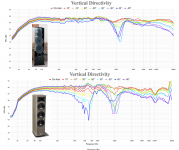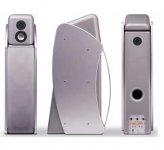For the better part of the last year, I've been tinkering with various designs, and as usual I can't settle on a solution.
Something that's stuck with me, is the experience of listening to the JBL 4367 back-to-back with the Revel F206 at CES a couple of years ago. While both speakers sounded very good, I'd argue that the Revel sounded nearly as good as the JBL... at less than 25% of the cost.
I've been reading the data over at audiosciencereview obsessively, and something I noticed is that the waveguides with narrow directivity seem to be at a disadvantage when it comes to the power response of the loudspeaker.
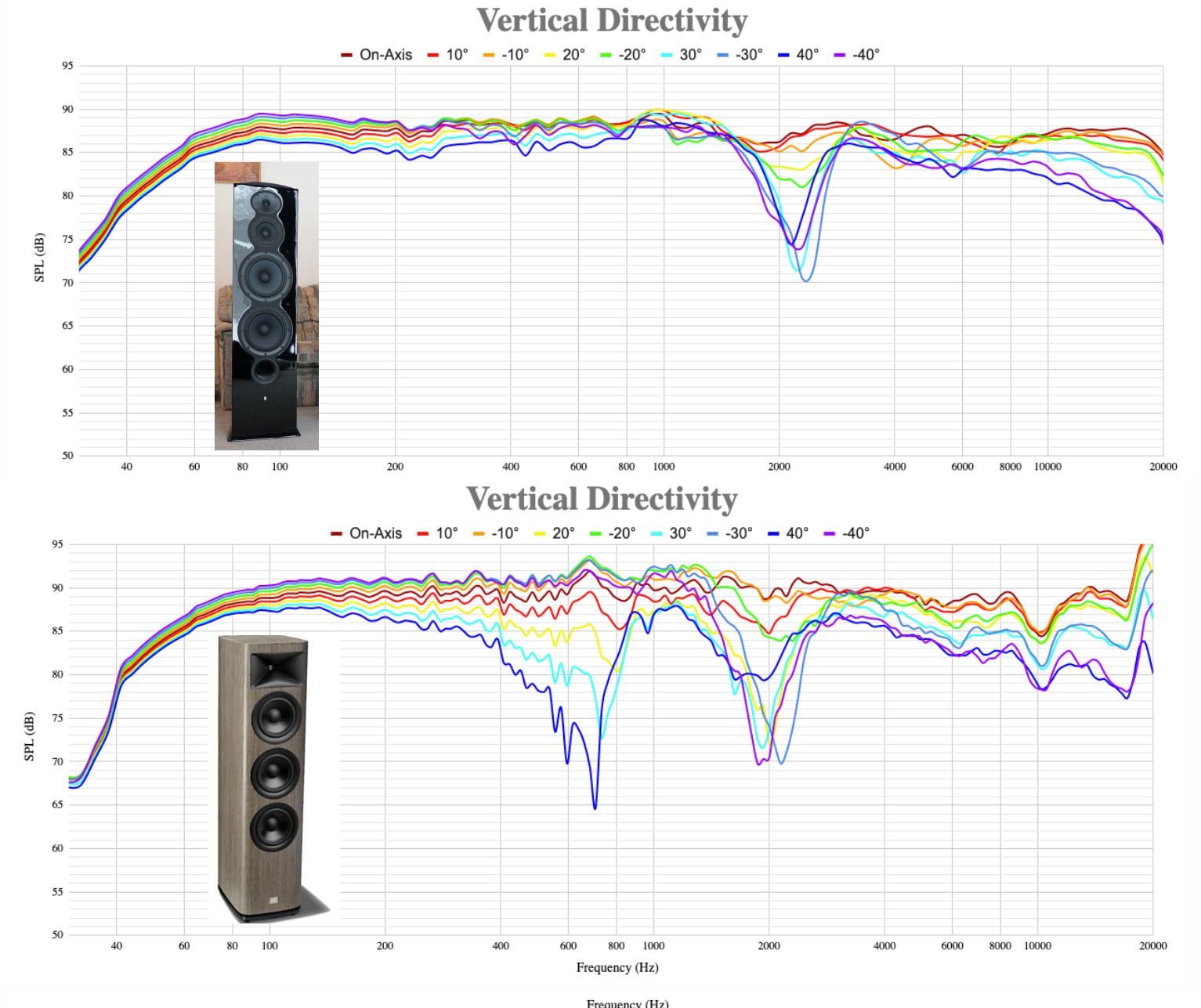
For instance the Revel F208 and the JBL HDI 3600 have a similar configuration. Each speaker has a tweeter, a midrange, and two woofers. Each speaker is optimized using the guidance of Sean Olive, who is a student of Floyd Toole.
As I've designed speakers and waveguides over the years, I've generally focused on the horizontal beamwidth and the vertical beamwidth has basically been an afterthought. But when I look at the measurements of the vertical directivity of speakers at audiosciencereview, I see a pattern emerge, where the speakers with narrow directivity have issues with the vertical directivity.
Here's why this is, IMHO:
It's fairly easy to dial in the horizontal beamwidth of a speaker. For instance, a 7" woofer has a cone that's about 6" in diameter, and because of this, the woofer will beam at 2,250hz. If you put your tweeter in a waveguide it's very straightforward to match the tweeters horizontal beamwidth to the woofer's horizontal beamwidth.
The vertical beamwidth is much trickier.
Kef and Genelec and Tannoy use a coax, and the measurements at audiosciencereview show that this is an effective solution.
With conventional drivers, this gets trickier. The JBL uses a waveguide with about sixty degrees of vertical beamwidth. The Revel uses a waveguide with about 120 degrees of vertical beamwidth.
The JBL will interact with the floor and the ceiling a LOT less than the Revel. But if you're listening to the JBL at even 12-24" above the tweeter, it's not going to sound great. If you're listening to the JBL at a distance of two meters, and your ears are less than 0.75 meters above the tweeter axis, there's a twelve decibel hole in the response. That's *definitely* going to be audible.
TLDR:
I've largely picked the horizontal beamwidth of my waveguides carefully, and chose the vertical beamwidth as an afterthought. The measured data from audiosciencereview seems to indicate that waveguides with wide beamwidth, driven by dome tweeters, may produce superior results to compression drivers on narrow beamwidth waveguides.
Something that's stuck with me, is the experience of listening to the JBL 4367 back-to-back with the Revel F206 at CES a couple of years ago. While both speakers sounded very good, I'd argue that the Revel sounded nearly as good as the JBL... at less than 25% of the cost.
I've been reading the data over at audiosciencereview obsessively, and something I noticed is that the waveguides with narrow directivity seem to be at a disadvantage when it comes to the power response of the loudspeaker.
For instance the Revel F208 and the JBL HDI 3600 have a similar configuration. Each speaker has a tweeter, a midrange, and two woofers. Each speaker is optimized using the guidance of Sean Olive, who is a student of Floyd Toole.
As I've designed speakers and waveguides over the years, I've generally focused on the horizontal beamwidth and the vertical beamwidth has basically been an afterthought. But when I look at the measurements of the vertical directivity of speakers at audiosciencereview, I see a pattern emerge, where the speakers with narrow directivity have issues with the vertical directivity.
Here's why this is, IMHO:
It's fairly easy to dial in the horizontal beamwidth of a speaker. For instance, a 7" woofer has a cone that's about 6" in diameter, and because of this, the woofer will beam at 2,250hz. If you put your tweeter in a waveguide it's very straightforward to match the tweeters horizontal beamwidth to the woofer's horizontal beamwidth.
The vertical beamwidth is much trickier.
Kef and Genelec and Tannoy use a coax, and the measurements at audiosciencereview show that this is an effective solution.
With conventional drivers, this gets trickier. The JBL uses a waveguide with about sixty degrees of vertical beamwidth. The Revel uses a waveguide with about 120 degrees of vertical beamwidth.
The JBL will interact with the floor and the ceiling a LOT less than the Revel. But if you're listening to the JBL at even 12-24" above the tweeter, it's not going to sound great. If you're listening to the JBL at a distance of two meters, and your ears are less than 0.75 meters above the tweeter axis, there's a twelve decibel hole in the response. That's *definitely* going to be audible.
TLDR:
I've largely picked the horizontal beamwidth of my waveguides carefully, and chose the vertical beamwidth as an afterthought. The measured data from audiosciencereview seems to indicate that waveguides with wide beamwidth, driven by dome tweeters, may produce superior results to compression drivers on narrow beamwidth waveguides.
Attachments
Interesting observations.
Would your findings in anyway imply that speakers with ribbon tweeters will fare worse, as the horizontal dispersion is limited?
Would your findings in anyway imply that speakers with ribbon tweeters will fare worse, as the horizontal dispersion is limited?
Very interesting post, Patrick. I think I agree, and it explaines something I have noticed: Designers of horns and wave guide speakers usually obsess over power response, and they should... It is hard to get the power response right with horns and wave guides.
But designers of direct radiator systems tend to view power response response as secondary to on-axis FR and off-axis horizontal FR. And this makes sense... With good design practice, IMO it is relatively easy to get an acceptable power response.
But designers of direct radiator systems tend to view power response response as secondary to on-axis FR and off-axis horizontal FR. And this makes sense... With good design practice, IMO it is relatively easy to get an acceptable power response.
One cannot get woofer close enough to a tweeter in waveguide to have smooth polar response. c-2-c spacing is too much no matter what is the crossover frequency if the waveguide is big enough to control directivity down to the crossover region (vertically). One would want the waveguide to be big enough so that woofer start beaming and waveguide widening so the two overlap nicely throughout the crossover region. Unless the woofer is inside the horn, a multiple entry horn.
Interesting observations.
Would your findings in anyway imply that speakers with ribbon tweeters will fare worse, as the horizontal dispersion is limited?
Horizontal dispersion is not the problem with ribbon tweeters; vertical dispersion is their weak spot.
One cannot get woofer close enough to a tweeter in waveguide to have smooth polar response. c-2-c spacing is too much no matter what is the crossover frequency if the waveguide is big enough to control directivity down to the crossover region (vertically). One would want the waveguide to be big enough so that woofer start beaming and waveguide widening so the two overlap nicely throughout the crossover region. Unless the woofer is inside the horn, a multiple entry horn.
Good promotion for co-axials 🙂
Interesting observations.
Would your findings in anyway imply that speakers with ribbon tweeters will fare worse, as the horizontal dispersion is limited?
I've been wondering the same thing!
I've discussed the use of beryllium tweeters with some designers that are really talented. Talked about this with Kevin Voecks from Revel at CES, and Andrew Jones has talked about this in some of his interviews. I've never used a beryllium tweeter in my life, but the consensus among those guys seems to be "yes it's really expensive but it makes a measurable and an audible difference."
I personally have a shelf full of ribbon tweeters. I never seem to use them, because sooner or later, I always come to the conclusion that a dome will work better.
Something that's interesting about the beryllium tweeters that Revel uses, is that they're significantly more efficient than their aluminum counterparts.
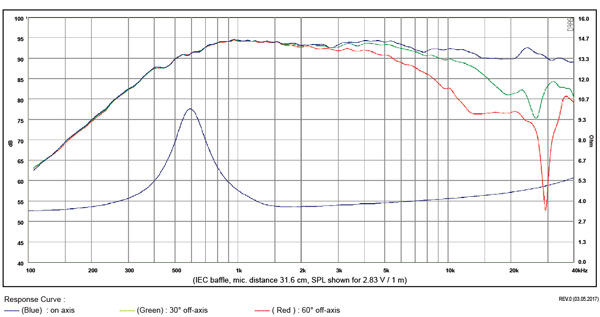
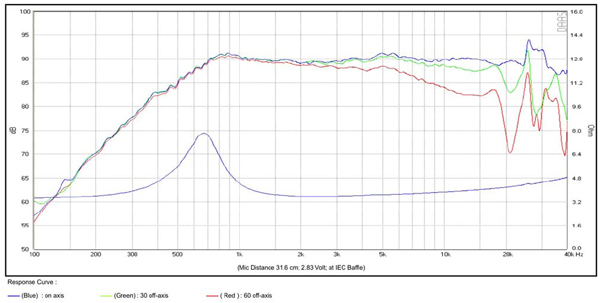
For instance, the $302 SB29BAC is about four dB more efficient than the $50 SB26ADC. From various tear downs of Revel speakers, it appears that the former tweeter is what's used in Revel's $1750 F206 speaker, and the latter tweeter is what's used in Revel's $3500 F226BE.
IE, the two speakers are NOT identical, but they are very similar, and what separates the affordable speaker from the one that's as expensive as a used car is the use of a $300 beryllium tweeter instead of a $50 aluminum tweeter.
Normally I'd balk at the idea of spending an extra $500 on a fancy tweeter, but when you consider that the investment will yield a speaker that plays more than 4dB louder with the same amount of power, it starts to make sense. Particularly since tweeters tend to be the weakest link in a loudspeaker...
Then again, ribbons are very efficient too, and maybe THAT is the solution. But the challenge with ribbons is that they tend to blow up...
I would have suspected the huge power hole in the midrange to be the problem with the JBL above., not the hole in the lower treble - which is worse than the Revel for sure, but IMHO not at all like the difference in the midrange of these two speakers. I wonder why the two manufacturers would use such different crossover points for woofer/mid? I bet the Revel is down around 200-300hz while the JBL is obviously double that.
Both dips are ugly, but note that the JBL is down fifteen decibels at just twenty degrees off axis, while the Revel is down four decibels.
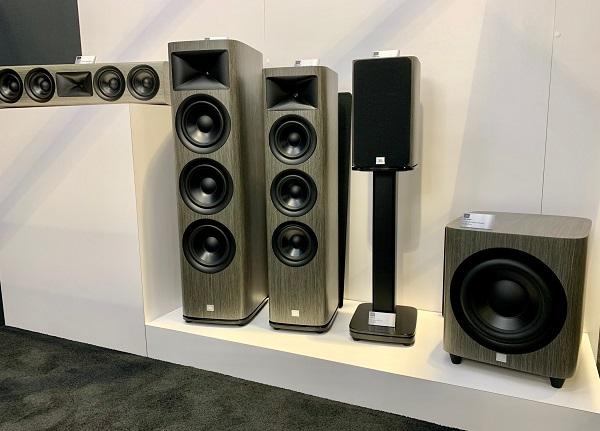
Even worse, the measurement is from JBL's HDI3600. The bigger speaker, with an 8" midrange, probably is much worse in this respect.
To me, it looks like they could have improved things if they:
3) Used a smaller midrange
2) Had tighter spacing
1) Used a waveguide with wider beamwidth
The Revel is a three way while the JBL is a 2.5way. Because all three woofers in the JBL are playing at low frequency, it winds up with a narrow vertical beamwidth and higher efficiency below 700Hz.
The fact that the JBL is a 2.5 way probably drove a lot of the xover decisions. For instance, if JBL had gone with a 5" midrange instead of a 6" midrange/woofer, the midrange would have become the Achilles Heel of the entire speaker (because all three drivers are playing at low frequency and the smaller mid wouldn't be able to keep up with the larger woofers.)

Even worse, the measurement is from JBL's HDI3600. The bigger speaker, with an 8" midrange, probably is much worse in this respect.
To me, it looks like they could have improved things if they:
3) Used a smaller midrange
2) Had tighter spacing
1) Used a waveguide with wider beamwidth
The Revel is a three way while the JBL is a 2.5way. Because all three woofers in the JBL are playing at low frequency, it winds up with a narrow vertical beamwidth and higher efficiency below 700Hz.
The fact that the JBL is a 2.5 way probably drove a lot of the xover decisions. For instance, if JBL had gone with a 5" midrange instead of a 6" midrange/woofer, the midrange would have become the Achilles Heel of the entire speaker (because all three drivers are playing at low frequency and the smaller mid wouldn't be able to keep up with the larger woofers.)
I think Patrick and the prior response re. C-C spacing are correct.
I have been thinking in my mind (need to cut wood!) about a design where the mid operates only in its piston range (Ka <= 1) to minimize its beaming in its passband with minimal spacing between the drivers vertically. It is difficult to achieve as it essentially requires a tweeter that can cross low (? Bliesma T34B?).
I found the helpful image.
Bill
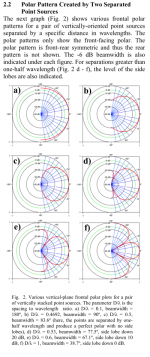
I have been thinking in my mind (need to cut wood!) about a design where the mid operates only in its piston range (Ka <= 1) to minimize its beaming in its passband with minimal spacing between the drivers vertically. It is difficult to achieve as it essentially requires a tweeter that can cross low (? Bliesma T34B?).
I found the helpful image.
Bill

The fact that the JBL is a 2.5 way probably drove a lot of the xover decisions. For instance, if JBL had gone with a 5" midrange instead of a 6" midrange/woofer, the midrange would have become the Achilles Heel of the entire speaker (because all three drivers are playing at low frequency and the smaller mid wouldn't be able to keep up with the larger woofers.)
This is one odd 2.5 way IMHO. The 2.5 I am familiar with cross the helper woofer/woofers much lower than 900Hz. Anyone have a schematic of the crossover???
Rob 🙂
Last edited:
Yep, to the idea that narrower vertical pattern in a wave guide makes it harder to achieve good polar response curves.
And more yep, to the need for tight c-to-c and matching ka's, and others' posts along same lines.
I think the biggest part of the problem is simply matching an asymmetric waveguide pattern with a symmetric single cone radiator pattern.
A single cone has same horizontal ka and vertical ka.
The waveguide by design, can't.
One of the two matchups H vs V has to give, and we all know horizontal is going to rule.
So to solve the vertical mismatch, in come designs with two or more cone radiators covering the frequency range that needs to mate with the waveguide.
They attempt to work as a line, to narrow their summed vertical directivity, to match the wave guide's vertical directivity.
So it's add drivers to make a mini-line, all the while trying to maintain c-to-c distances close enough that it all works.
And also trying to make sure a vertical directivity mismatch wasn't created on the bottom xover side of the mini-line drivers mating with the waveguide. (looks like that's a second big mismatch with the JBL HDI 3600)
Makes synergies look easier every time i think about it Lol 😀
And more yep, to the need for tight c-to-c and matching ka's, and others' posts along same lines.
I think the biggest part of the problem is simply matching an asymmetric waveguide pattern with a symmetric single cone radiator pattern.
A single cone has same horizontal ka and vertical ka.
The waveguide by design, can't.
One of the two matchups H vs V has to give, and we all know horizontal is going to rule.
So to solve the vertical mismatch, in come designs with two or more cone radiators covering the frequency range that needs to mate with the waveguide.
They attempt to work as a line, to narrow their summed vertical directivity, to match the wave guide's vertical directivity.
So it's add drivers to make a mini-line, all the while trying to maintain c-to-c distances close enough that it all works.
And also trying to make sure a vertical directivity mismatch wasn't created on the bottom xover side of the mini-line drivers mating with the waveguide. (looks like that's a second big mismatch with the JBL HDI 3600)
Makes synergies look easier every time i think about it Lol 😀
Last edited:
Horizontal dispersion is not the problem with ribbon tweeters; vertical dispersion is their weak spot.
daanve,
Slip of the keyboard...had meant to write vertical dispersion. 🙂
I've put a pair of mirage nanosat speakers on top of my large waveguides, they face the back wall, are wired to rear surround, and I use dolby pro logic II movie. It grabs ambient sounds and also adds 10ms delay. It adds an ambience that is much lacking from the 90 degree directivity mains. A few of my friends have heard it and the consensus was that the system sounded much better this way.
I've had it for a few weeks now and don't plan on going back.
I think any small bookshelf speaker will do. I don't believe the Mirages are actually omni, just very wide directivity.
I think this is the next frontier. We are capable of excellent directivity control for mains, it's about adding the ambience now. imo.
I've had it for a few weeks now and don't plan on going back.
I think any small bookshelf speaker will do. I don't believe the Mirages are actually omni, just very wide directivity.
I think this is the next frontier. We are capable of excellent directivity control for mains, it's about adding the ambience now. imo.
Last edited:
You have to read that graph above very carefully because the JBL is much worse vertically in the positive direction (above the tweeter) than it is in the negative. It's only 5dB down at 20 deg below.Both dips are ugly, but note that the JBL is down fifteen decibels at just twenty degrees off axis, while the Revel is down four decibels.
As noted by Amir in the review this speaker is very sensitive to the height that it is placed.
The listening window measurement is very good which shows that if it is placed correctly it will perform pretty well.
to Robh3606:
coming back to M2 horn, is-it feasible to make a passive network to EQ it using 2452H-SL driver?
Having both D2430 and 2452SL would you reccomend 2452SL?
How does-it compare to STX waveguide and the PTH1010?
crossed to a 2206 or 2226 or 1400pro round 700Hz
coming back to M2 horn, is-it feasible to make a passive network to EQ it using 2452H-SL driver?
Having both D2430 and 2452SL would you reccomend 2452SL?
How does-it compare to STX waveguide and the PTH1010?
crossed to a 2206 or 2226 or 1400pro round 700Hz
I've done alot of research on this very issue, concerning the differences between direct radiators, dipoles, fullrange omnis, cardiodes, controlled directivity waveguide systems or a mix of these. I like and dislike direct radiating and waveguide/horn loaded systems both for various reasons.
There is one type of speaker however I downright loath and believe it has no place in high fedility reproduction - I'm referring to any speaker that has one or more additional high frequency radiating elements firing in any other direction than forward at your ears (this excludes dipoles, open baffles and omnis i.e. Walsh). This "Bose" recipe BS I'm referring to, completely ruins any attempt by the engineer or artist who has tried to capture and preserve a realistic sounding acoustical performance in the space it was originally performed in. It would never be able to recreate a realistic pinpoint stereo image of a vocalist sitting right in front of you.
When you play back a live recording which was made with minimal micing (ideally an omnidirectional stereo pair positioned in a binaural way i.e. ORTF, Decca Tree, Blumlein), you are listening to the entire acoustic event, including reflections already coming off the back walls or boundaries of the original acoustic space. You wouldn't deliberately throw some or most of the HF range of the same audio signal back at the walls to have it reflected and scattered around again, then expect to end up with a lifelike stereo image as if you were present, listening to the original performance.
While I admit that 99% of music recordings don't adhere to the ideal recording scenario, most of them still attempt to (re)create a somewhat believable acoustic space which can be euphonic at the same time. Imagine listening to a recording with multiple types of conflicting reverb and delay mimicking many different spaces all at once (i.e. guitar sounds like its in a bathroom while the vocals are in a church and the piano is dry in a small room). That would mess with your head in a bad way and ruin the enjoyment, unless you're on drugs and actually like that sort of thing.
I listen to almost all kinds of music, even EDM and electronic synth music. My biggest enjoyment is when the speakers acoustically disappear and the music takes you to a different space, as if the musicians are in front of you, being able to reach out and point to their exact location with your eyes closed. It could be jazz, prog rock, 80s pop, blues, RnB, Motown, etc. As long as its recorded decently and played back through a good system. Even if the music wasn't that thoughtfully recorded or engineered, you still benefit from well imaging speakers with a reasonably flat FR, low distortion and sufficient dynamic range at all frequencies.
I've recorded and mastered a bit of music back when the preferred recording media was 2 inch analog tape. A trick we used to employ in mastering was to play back the recording through a large PA or the big soffit mount 3 way JBLs, then re-mic it and mix a portion of the playback with direct audio together for a more live performance like sound. Many other engineers used similar methods. All the Depeche Mode albums after Black Celebration were mastered this way. Its a very effective way to create that live concert sound and still give you the impression of a studio recording.
So, to sum this up, there are many decent speakers out there, but NONE of them have tweeters that fire sideways or backwards. No mastering engineer would consider this type of speaker. If this is your cup of tea, that's up to you, but don't ever label it as anything but fake trickery or an audio novelty. It will never function as a sonically plausible, believable way to enjoy prerecorded music.
There is one type of speaker however I downright loath and believe it has no place in high fedility reproduction - I'm referring to any speaker that has one or more additional high frequency radiating elements firing in any other direction than forward at your ears (this excludes dipoles, open baffles and omnis i.e. Walsh). This "Bose" recipe BS I'm referring to, completely ruins any attempt by the engineer or artist who has tried to capture and preserve a realistic sounding acoustical performance in the space it was originally performed in. It would never be able to recreate a realistic pinpoint stereo image of a vocalist sitting right in front of you.
When you play back a live recording which was made with minimal micing (ideally an omnidirectional stereo pair positioned in a binaural way i.e. ORTF, Decca Tree, Blumlein), you are listening to the entire acoustic event, including reflections already coming off the back walls or boundaries of the original acoustic space. You wouldn't deliberately throw some or most of the HF range of the same audio signal back at the walls to have it reflected and scattered around again, then expect to end up with a lifelike stereo image as if you were present, listening to the original performance.
While I admit that 99% of music recordings don't adhere to the ideal recording scenario, most of them still attempt to (re)create a somewhat believable acoustic space which can be euphonic at the same time. Imagine listening to a recording with multiple types of conflicting reverb and delay mimicking many different spaces all at once (i.e. guitar sounds like its in a bathroom while the vocals are in a church and the piano is dry in a small room). That would mess with your head in a bad way and ruin the enjoyment, unless you're on drugs and actually like that sort of thing.
I listen to almost all kinds of music, even EDM and electronic synth music. My biggest enjoyment is when the speakers acoustically disappear and the music takes you to a different space, as if the musicians are in front of you, being able to reach out and point to their exact location with your eyes closed. It could be jazz, prog rock, 80s pop, blues, RnB, Motown, etc. As long as its recorded decently and played back through a good system. Even if the music wasn't that thoughtfully recorded or engineered, you still benefit from well imaging speakers with a reasonably flat FR, low distortion and sufficient dynamic range at all frequencies.
I've recorded and mastered a bit of music back when the preferred recording media was 2 inch analog tape. A trick we used to employ in mastering was to play back the recording through a large PA or the big soffit mount 3 way JBLs, then re-mic it and mix a portion of the playback with direct audio together for a more live performance like sound. Many other engineers used similar methods. All the Depeche Mode albums after Black Celebration were mastered this way. Its a very effective way to create that live concert sound and still give you the impression of a studio recording.
So, to sum this up, there are many decent speakers out there, but NONE of them have tweeters that fire sideways or backwards. No mastering engineer would consider this type of speaker. If this is your cup of tea, that's up to you, but don't ever label it as anything but fake trickery or an audio novelty. It will never function as a sonically plausible, believable way to enjoy prerecorded music.
So, to sum this up, there are many decent speakers out there, but NONE of them have tweeters that fire sideways or backwards. No mastering engineer would consider this type of speaker. If this is your cup of tea, that's up to you, but don't ever label it as anything but fake trickery or an audio novelty. It will never function as a sonically plausible, believable way to enjoy prerecorded music.
Kevin Voecks has been on a thirty year streak of making speakers that people love, and his top of the line speaker from 20 years ago has a rear firing tweeter.
Attachments
- Home
- Loudspeakers
- Multi-Way
- The Preference for Direct Radiators
